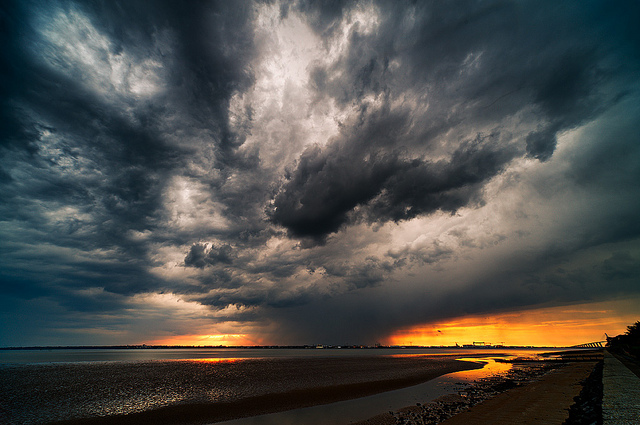
The weather forecast does more than just dictate what you should wear each day; changes in weather patterns can also affect migraine sufferers. Recent research suggests that changes in barometric pressure impact at least one out of every two migraine sufferers – which means millions of Americans are affected each day.
According to a research report from Marcelo E. Bigal, MD, PhD, director of research at the New England Center for Headache in Stamford, Conn., and assistant professor of neurology at Albert Einstein College of Medicine in New York, just over half of all migraine patients (51%) suffer from weather-related migraines. Barometric pressure migraines are one of the most common types of weather related triggers.
Most significantly, Bigal’s report found that it was not the weather itself that triggered the migraines, but the change in weather patterns.
Ironically, “change” is the one “constant” in weather related triggers. And it’s not just changing weather patterns that trigger migraines. Over the last decade, researchers have increasingly realized that change in all forms, from shifts in sleep patterns to fluctuations in estrogen levels, are associated with migraines.
Weather related triggers affect patients differently. Researchers found:
-
34% of migraine sufferers were sensitive to changes in temperature or humidity levels
-
14% of migraine sufferers were sensitive to changes in weather patterns
-
13% of migraine sufferers were sensitive to changes in barometric pressure
One out of every 10 migraine sufferers are sensitive to multiple weather changes, including barometric pressure migraine pain.
How Barometric Pressure Affects Migraines
So, why are migraine sufferers affected by weather changes when the average individual is not impacted at all? According to Bigal, the brains of migraine sufferers are “extremely sensitive”. Consequently, stimulation that has little to no effect on migraine sufferers can trigger migraines in those who are prone to them.
Weather related triggers – especially barometric pressure drops – are most likely to trigger a migraine. An approaching storm is one of the most common weather related triggers, although even the barometric pressure changes associated with air travel can impact sufferers. When combined with other aspects of the weather, such as temperature extremes or humidity, the likelihood of developing a barometric pressure migraine increases.
According to Dr. Matthew Fink, neurologist in chief at New York-Presbyterian Hospital/Weill Cornell Medical Center, a low barometric pressure migraine occurs because of the difference in pressure between the surrounding atmosphere and the sinuses. Dr. Fink compares the onset of a barometric pressure migraine to the pain suffered by arthritis patients right before a coming storm. Just as some individuals experience aches and pains in their knee joints, so too will migraine sufferers experience migraine pain.
In contrast, high barometric pressure does not usually cause a problem, unless it is extreme change. A high barometric pressure migraine is most likely to affect scuba divers who ascend too rapidly towards the surface. When divers ascend too quickly, nitrogen that has been dissolved in the blood expands into gas bubbles, creating internal distress as the barometric pressure increases. This causes the bends, which can be fatal. Unless migraine sufferers are diving, however, it is unlikely that they will suffer a high barometric pressure migraine.
How Warm Weather Affects Barometric Pressure Migraine Risk
In general, barometric pressure changes and weather related triggers may have the most significant impact on migraine sufferers during warmer weather. One study of 7,000 migraine patients found that a higher ambient temperature increased the risk for serious migraines that required an emergency room evaluation. Every nine-degree increase in ambient air temperature corresponded with a 7.5% increased risk for developing a migraine requiring emergency intervention. When barometric pressure was lower in the previous 48 to 72 hours, this also translated to an increased risk for developing a barometric pressure migraine.
However, a change in barometric pressure does not automatically mean that individuals are doomed to suffer from a migraine. Stress and hormone fluctuations also impact whether an individual will develop a migraine. Think of the brain as the control center for migraine development. Your brain receives input from multiple triggers, ranging from stress to barometric pressure changes. Dietary choices, certain medications and sleep deprivation also affect this stack. As these triggers stack up, your total trigger level increases. If the stack rises above your personal limit of tolerance (i.e., your individual migraine threshold), a migraine may be set in motion. The degree of this pain depends in part on how high your migraine threshold level climbed.
How to Control Migraine Headaches
Research suggests that migraines are hereditary. However, simply because a parent or sibling suffers from intense migraines, does not mean that you will also experience migraine pain. Differences in diet, medication, sleep and exercise habits can significantly impact migraine threshold levels.
From a practical standpoint, you cannot stop a summer thunderstorm from developing or avoid all warm weather temperatures. Weather related triggers cannot be entirely avoided. And while you cannot control weather related triggers, you can control other factors that may aggravate migraine headaches. This includes taking medication to help minimize migraine pain and avoiding known lifestyle triggers, including certain types of food, alcohol, stress and sleep disturbances.
Image Source: Leo Reynolds

